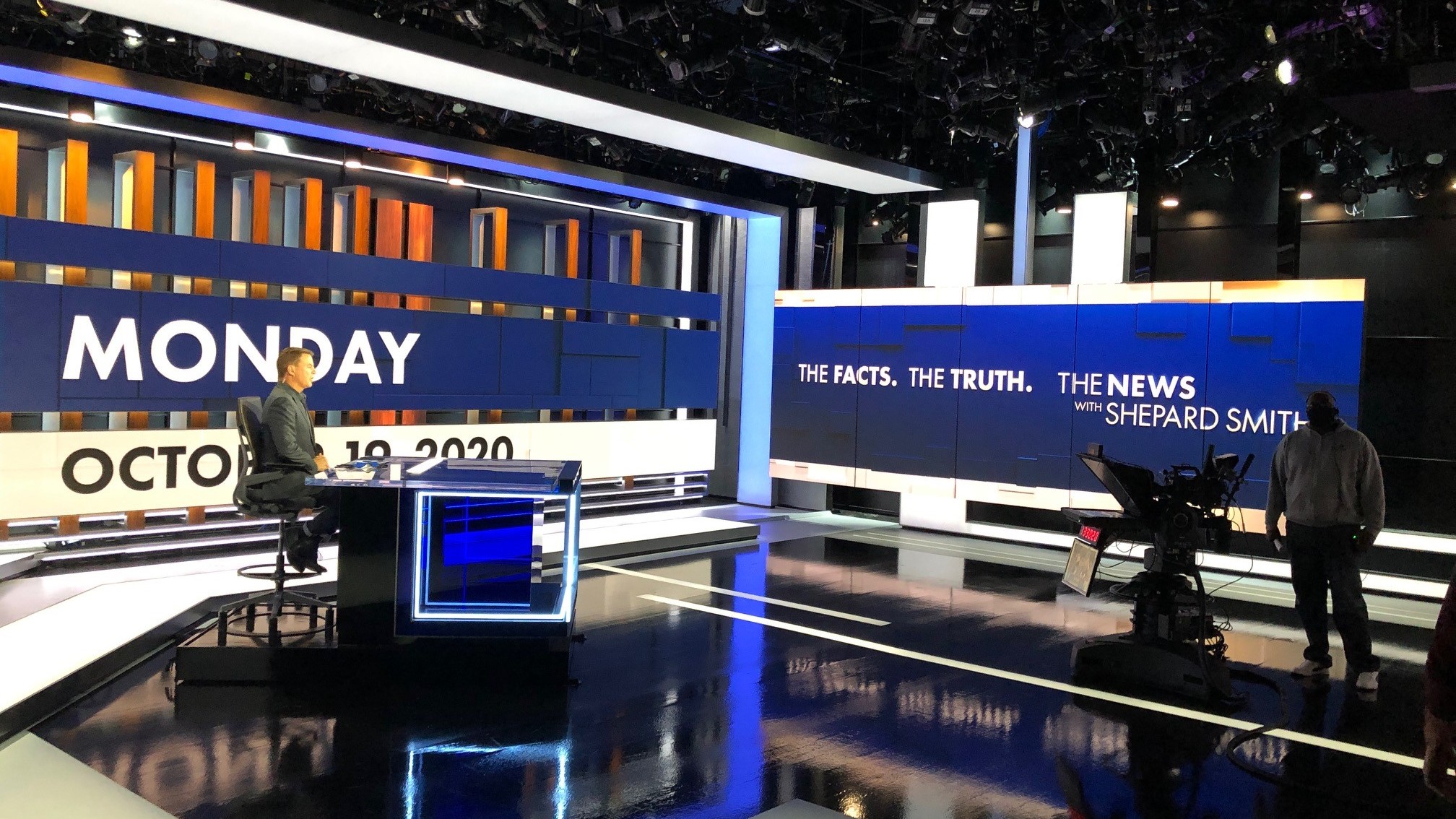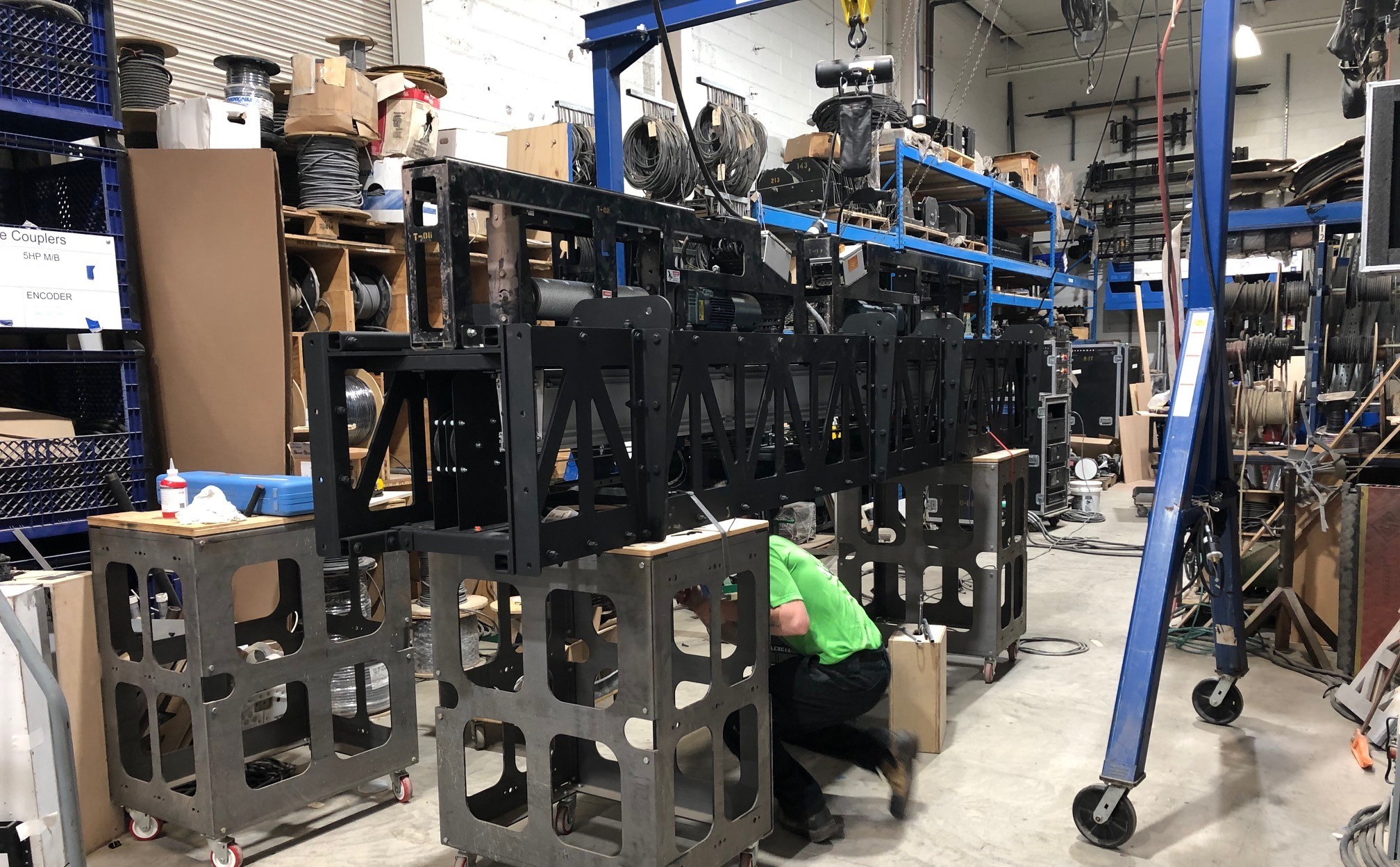‘News With Shepard Smith’ Set Immerses Audience, Anchor in Video
Set, constructed entirely during pandemic, features video monitors that give flexibility to how news is presented

ENGLEWOOD, N.J.—Broadcast news allows viewers to see the important events happening around the world. CNBC’s new program, “The News With Shepard Smith,” has taken that idea and made it the focal point of its set, which features a bevy of video monitors designed to present the news in flexible and innovative ways.
Smith will premiere the new set next week (Oct. 26-Oct. 30), after using a temporary set for the first few weeks since the show debuted, the result of what Steve Fastook, senior vice president of operations and engineering at CNBC, described as “the most difficult set we’ve ever built,” not just because of the intricacies of the set’s tech, but because of the forced adjustments caused by the COVID-19 pandemic.
THE BUILD
CNBC announced that Shepard Smith was joining the network on July 8, which with the show debuting in the fall, called for an extremely fast-paced construction, especially considering the average build time for a set, according to Fastook, is 35 weeks. And for what is expected to be one of the network’s marquee programs, it couldn’t just be any old set.
“This is probably the largest single set we’ve ever encountered,” said Fastook. “It’s technically complex; very, very intricate; video everywhere.”
As the first set built by CNBC during the COVID era, the process had to be adapted to make sure that everyone was safe and followed the proper protocols. This ranged from using two set shops—Showman Fabricators in Bayonne, N.J., and Sacks Exhibitors in Andover, Mass.—to build the different set pieces, and having specific credentials for those working on the set as they entered CNBC’s headquarters, in addition to the typical temperature checks and other social distancing efforts.
The actual build took place in Studio B at CNBC’s global headquarters in Englewood, a 60x60-foot space, which had to be gutted. One of the bigger projects in the build involved cutting the lighting grid to build a custom structure to hold the 15,000-pound metal rig that would be used to hold the set’s main video monitor.

COVID safety protocols were also incorporated into the final design and build of the set, with the backstage area designed so that a console could be operated while still maintaining 6 feet of distance between crew members.
The professional video industry's #1 source for news, trends and product and tech information. Sign up below.
THE CENTERPIECE
The defining element of the set is the video monitor that is held up by the specially designed rig previously mentioned. With in-studio guests not a reliable option currently, Fastook said they had to develop a compelling way to visually present the correspondents from all over the world. The solution, five vertical, life-size monitors that can either work together to show a single image or video, display five individual videos or any combination in between.

The individual monitors, which are all 1.2mm pitch direct LED screens, can also be moved mechanically to create a desired look, Fastook explains. The plan is to be able to move them on camera for the viewers to actually see. The center monitor is designed so it can emerge away from the other monitors 17 feet in six or seven seconds, allowing the monitor to show a correspondent as if they are coming out to meet Smith.
“Imagine the California wildfires,” said Fastook. “The visuals of the fire fill up the wall, and then the center monitor transitions to the correspondent and moves away from the rest of the wall and toward you.
“This is probably one of the coolest things that we’re going to do,” he continues. “At the end of the day, it’s all about being immersed in the stories.”
Fastook does acknowledge that the full motion of the monitor is likely not going to be used right away, as many elements of the new set will be introduced over the next few weeks as the crew gets comfortable using them.
The immersion goes beyond just the main video monitor, though. There are five additional vertical monitors placed throughout the studio and the windows wall, the wall in the back of the set that is made up of three bands.
“This set is all video,” said Fastook. “Anywhere you look, there’s video elements. So every single shot, not only does the team have to plan the shot, but they have to plan what’s in the monitors behind and they have to make clean transitions in the monitors behind. So the level of complexity producing on this set is multiple times greater than just a traditional set.”
‘NEVER SEEN ANYTHING LIKE THIS’
While the monitor may be what initially draws people’s eyes, Fastook takes pride that their goal of creating a high-tech, innovative set has been met. “[E]verybody that has come across it in the building has come in saying, ‘I’ve never seen anything like this.’”
In addition to the monitor, the studio includes an array of LED lights that can offer a reported 17,000 color combinations. There are additional stage and open areas on the set that will allow for different setups for guests and presentations when COVID restrictions lift. And, with all of this high-tech equipment, Fastook says that Studio B uses only 10% of the power that CNBC’s Studio C, which is the home of “Mad Money,” does, despite being a larger set.
“I have to say I’m so proud of my team,” Fastook said. “This is the most difficult set we’ve ever built, for obvious reasons—it was fast scheduled and COVID—and highly intricate and highly technical. Every single person on my team and everyone we worked with really went above and beyond on this one. It’s a great moment for them. I’m really, really proud of them.”
See a timelapse of the set's construction below:
